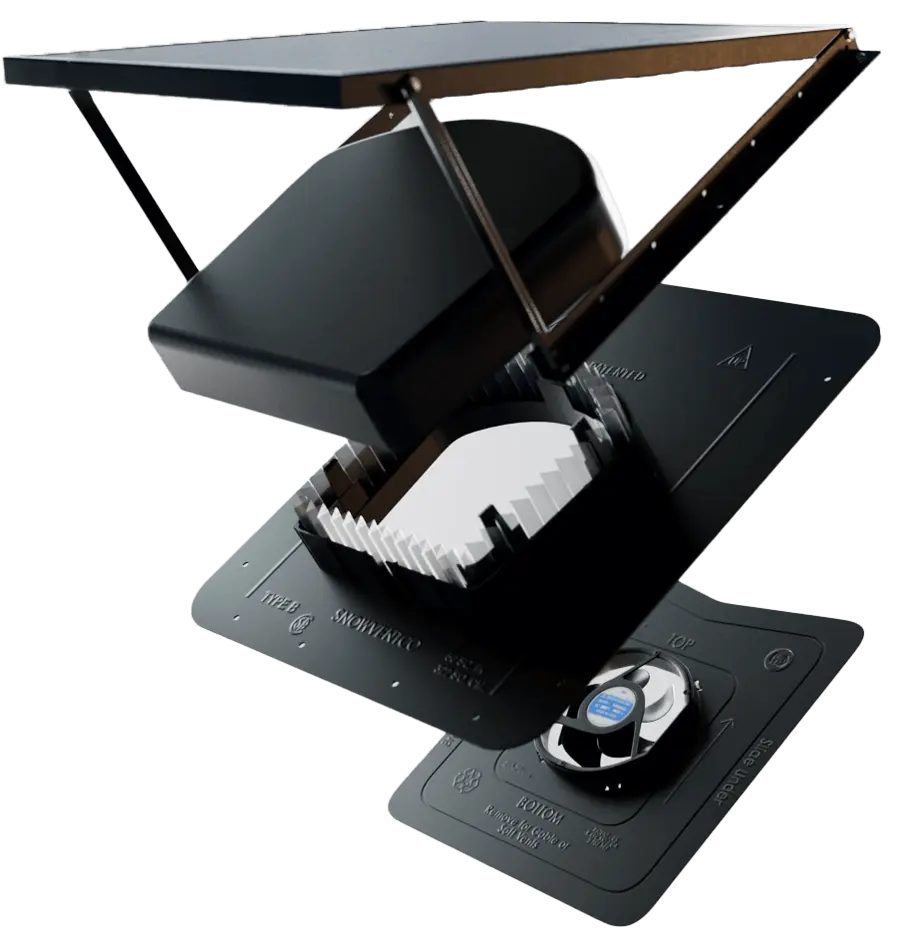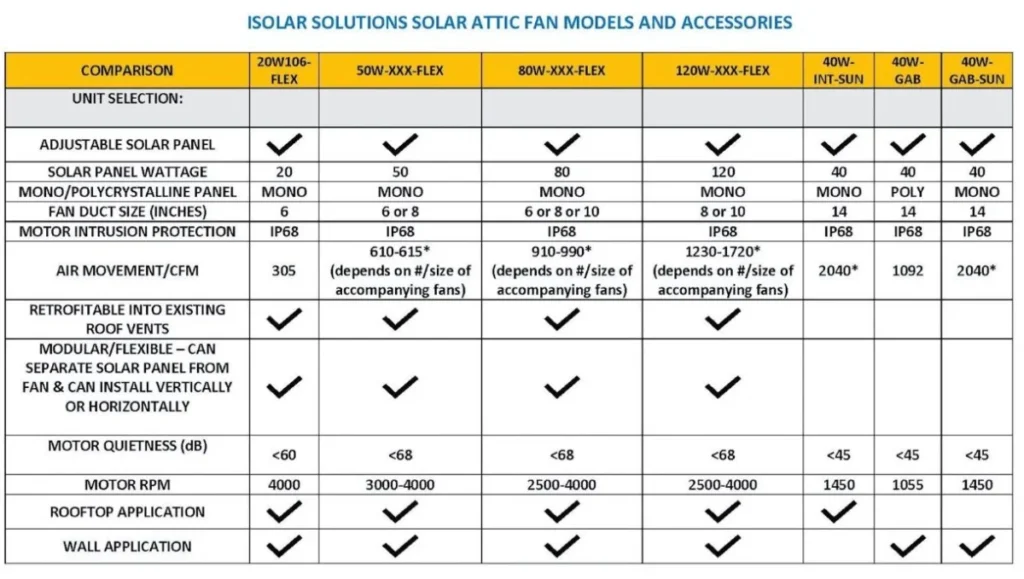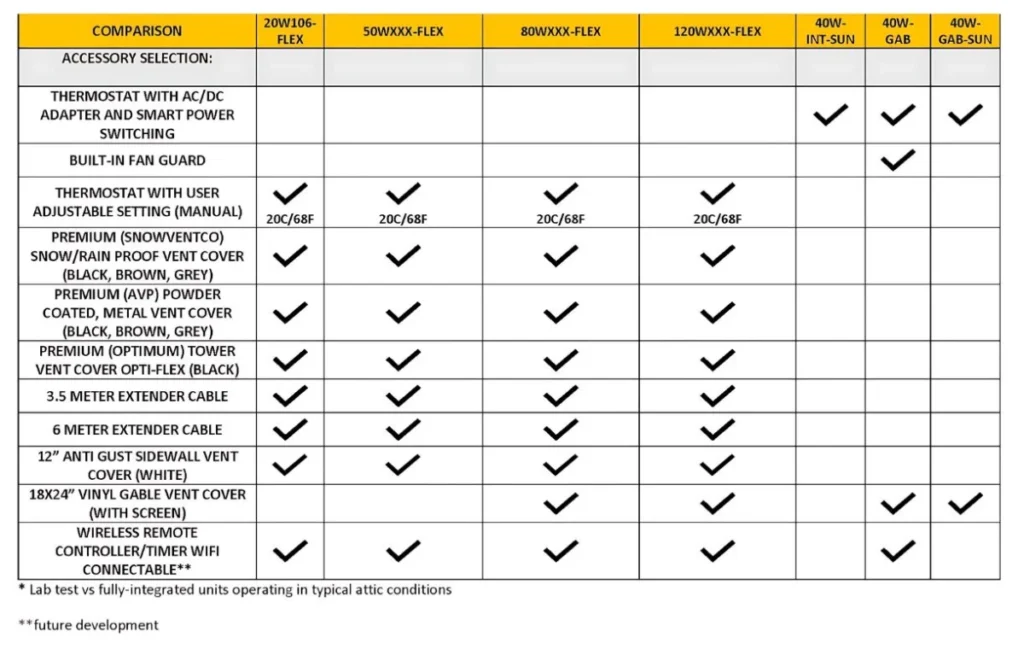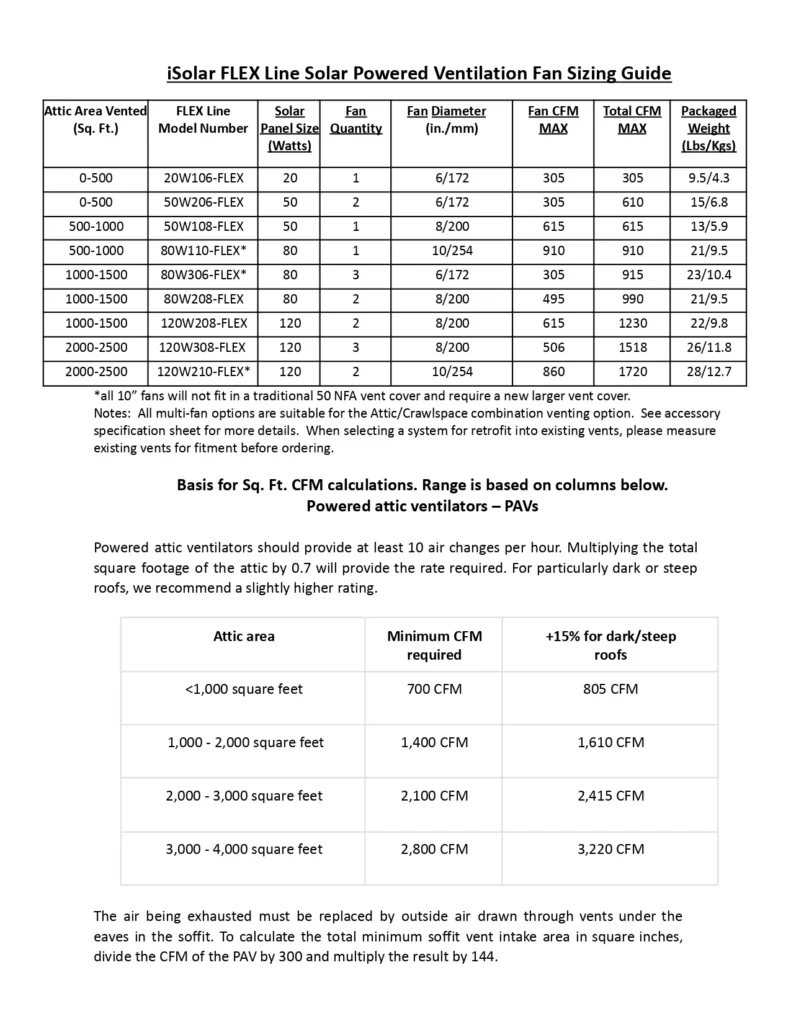An iSolar Attic Fan harnesses solar power to remove extreme heat and humidity in residential attic spaces to reduce energy use, increase comfort, prevent mold and mildew, evacuate possible harmful odors and gasses, creating a healthier environment, and prolonging the life expectancy of roofing materials and air-conditioners.
The solar-powered attic fan provides different benefits in summer and winter:
- In summer it reduces attic temperatures. This helps cool the home naturally due to lower demand on the air-conditioning (AC), which results in lower electricity expenditures.
- In winter, the iSolar Attic Fan prevents rot, mildew and mold. As warm air cools on contact with roofing materials, moisture condenses, leading to the development of rot, mildew and mold—all of which will cause serious damage and become a risk to the air quality. The solar attic fan actively improves attic air circulation and helps prevent rot and growth of mold and mildew. In northern climates the iSolar Attic Fan also helps prevent ice dam formation on eaves troughs. In poorly ventilated attics, heated air causes snow and ice to melt from the roof and run down to the eaves where it freezes again, forming hazardous ice dams and sizable icicles. This can also cause interior water damage. Increased ventilation from a solar attic fan decreases the chance of ice damming.
Most houses built before 1984 will see greater energy savings due to lower attic insulation requirements.
The iSolar Attic Fan extends the life of roofing materials. Asphalt shingles are designed to withstand abuse from the sun over many years, though they are subjected to damaging temperatures as a result of an over-heated attic. If you see shingles beginning to curl up, you have an attic that doesn’t get adequate air circulation. The robust ventilation offered by the iSolar Attic Fan lowers attic temperatures, extending the life of roofing materials.
As the iSolar Attic Fan operates, the draw on air-conditioning diminishes, resulting in a longer life span of the air-conditioner.
Wholesale Purchasing (for Contractors): As a home improvement contractor of roofing, insulation or any other attic-related solutions your company can acquire our product, with special volume wholesale pricing, by applying to become part of our iSolar family, simply with a submission here: https://isolarsolutions.com/contractors
Online Purchasing (for Homeowners): We have a few options such as right here on our website where you can customize a product that’s right for you: https://isolarsolutions.com/shop/
We are also conveniently available on these platforms as well: amazon.ca, amazon.com, wayfair.ca, and walmart.ca.
It is recommended that a professional contractor install your solar attic fan. You may also contact one of our approved local roofing, insulation and attic ventilation contractors, found here: https://isolarsolutions.com/homeowners/#installers-map.
Absolutely! Extensive studies of the Solar Attic Fan’s performance have been completed and the tests are positive. In the past, the engineering community had expressed concerns that the Solar Attic Fan could potentially create negative pressure in homes with well-insulated attics. This has been debunked by the industry experts and has proven to be completely inaccurate. The iSolar Attic Fan moves a range of cubic feet per minute (CFM) when operating at peak sunlight. This is about the same amount of air movement that occurs when one uses bathroom fans or stove-top fans. It has been proven that there is no risk of creating an imbalance of pressure between the conditioned space of the house and the attic, especially with the appropriate level of soffit venting.
Independent testing has been proven that the iSolar Attic Fan, in addition to reducing the risk of mold in the attic, is capable of reducing thermal heat transfer from the attic to the conditioned house space resulting in savings due to decreased air conditioning.
Most homes are constructed with passive ventilation systems that rely on natural convection to provide some level of ventilation. In many jurisdictions, passive units are used to meet minimum building code requirements, but the 100% iSolar-powered, mechanical ventilation units are used to actively circulate and exhaust hot attic air, thus improving home comfort with no increase to the electricity bill.
Yes, there are alternatives such as wind-powered roof vents, and electrically powered roof fans. However, neither have the range of benefits of iSolar Attic Fans:
- While a Solar Attic Fan provides active circulation and ventilation on hot summer days, wind-powered units fail on the most uncomfortable summer days when there is no breeze at all.
- Electrically powered roof fans seem comparable with solar-powered units. But, while the solar-powered unit decreases electricity costs (as it is powered by the sun), the electrically powered unit increases electricity bills.
The iSolar Attic Fan FLEXLine of fans is expertly designed for horizontal or vertical installation, with installation on three different attic methods: gable-end, soffit installations, and easy retrofitting of existing or new rooftop vents, AND can also be installed to ventilate crawl spaces.
We recommend your Solar Attic Fan be installed by a professional who is licensed and insured to work on a roof. It will take less than 1 hour.
Please see our list of approved contractors to find the closest, certified installer near you. If you do not have one close by please submit your information on the contact page and we will help you find a resource.
Please find our warranty information here: https://isolarsolutions.com/warranties/
We can also assist with inquiries about servicing your Solar Attic Fan. Please contact us for service and warranty inquiries or if you have any questions. We will get back to you as quickly as possible.
Yes. The Solar Attic Fan is designed to lower your peak temperature electricity usage when this relief is needed most. The beauty of the iSolar FLEXLine system is that it automatically adjusts the fan speed to the amount of available sunlight and, therefore, the amount of heat building up in your attic. iSolar’s objective is to make its Solar Attic Fan as simple and sustainable as possible and to avoid unnecessary and bulky additions such as batteries, AC power adapters, extra solar panels, and regulator components.
Also, as the Solar Attic Fan is designed simply to remove excess heat in summer and moisture in winter, no timers or controls are needed. In late winter and early spring, when ice damming is likely to happen in an attic because of moisture, the fan will become more exposed to sunlight as the snow melts and will remove excess moisture, which will help the roof last longer. Air movement will help reduce the condensation as well as reducing the possibility of mold and rot within the attic*.
*Winter operation when the optional thermal switch is off.
If the venting intake is properly designed, the air will flow in through the lower, soffit venting, and then through the iSolar Attic Fan. The iSolar Attic Fan will not cause a furnace to work harder unless there is a badly leaking ceiling between the living space and the attic space. In many northern areas, snow may temporarily cover the solar panel during the coldest winter months, meaning that the Solar Attic Fan will not be on needlessly and would not move extra air through your attic space when it’s not needed. Finally, if the sun is out and the snow has melted enough to uncover the solar panel along with much of the roof of your home, the attic space in your roof will actually already be heating up to temperatures where the Solar Attic Fan can be helpful. The fan will automatically start moving excess hot air out of the attic and will power down when no longer needed—when the sun sets and there is no excess heat in the attic space. It’s that simple: it will work precisely as engineered*.
*Winter operation when the thermal switch is off.
- Minimizes air-conditioner activation and runtime
- Flattens summer peak electricity demand when electricity prices are highest as the Solar Attic Fan is off-grid (not hard-wired)
- Reduces annual energy consumption (while a/c activated)
Solar-Powered Attic Fan
Installation Guide and CheckList
Recommended Solar Attic Ventilation Air Flow Rates Per Square Feet Of Attic Area
According to the Home Ventilation Institute, these are the recommended ventilation rates for attics using Powered Attic Ventilators:
Powered attic ventilators – PAVs
Powered attic ventilators should provide at least 10 air changes per hour. Multiplying the total square footage of the attic by 0.7 will provide the rate required. For particularly dark or steep roofs, we recommend a slightly higher rating.
Attic area in square feet | CFM required | +15% for dark/steep roofs |
1,000 square feet | 700 CFM | 805 CFM |
2,000 square feet | 1,400 CFM | 1,610 CFM |
3,000 square feet | 2,100 CFM | 2,415 CFM |
The air being exhausted must be replaced by outside air drawn through vents under the eaves in the soffit. To calculate the total minimum soffit vent intake area in square inches, divide the CFM of the PAV by 300 and multiply the result by 144.
Use this sizing guide to determine the correct FLEXLine system for your home.
Important:
Solar Attic Fan quantities on any roof should not exceed 1/3 of the number of existing passive vents; Two Solar Attic Fans should never be installed too close to each other (at least 5 feet apart); and it is important to spread the ventilation points as far apart as possible and as close to the apex of the roof as possible.





